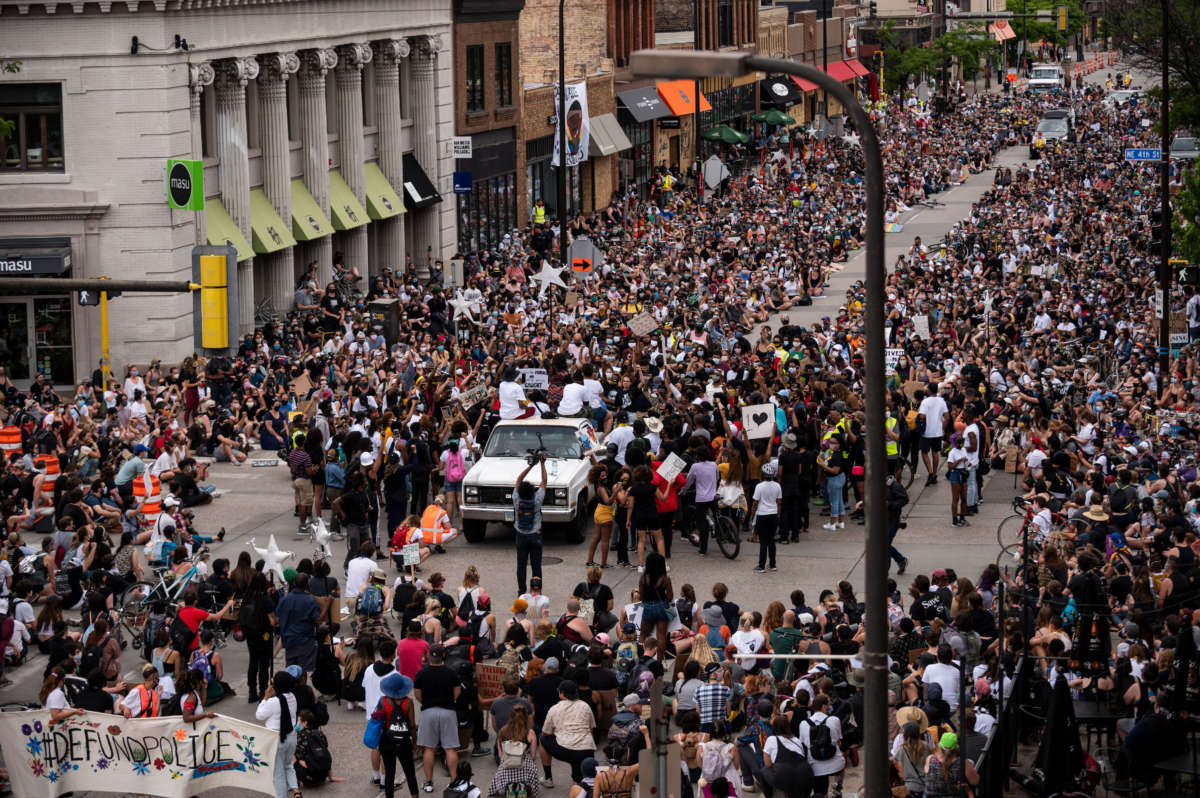Part of the Series
The Road to Abolition
In 2018, members of the Minnesota grassroots groups Reclaim the Block and Black Visions Collective dropped a banner at Minneapolis City Hall. On it were two lists: on the left, three budget items on the Minneapolis Police Department (MPD) budget, totaling $9 million. The right side was significantly longer, listing programs and organizations where the city could invest those $9 million to promote community safety — like domestic violence programs, housing and harm reduction. We were calling on the city to move our community’s dollars out of the violent, untrustworthy MPD, and into programs that actually keep us safe. That year, the city council moved $1 million from MPD’s budget into violence prevention — a drop in the bucket of the MPD’s $180 million budget, but a significant investment for underfunded anti-violence work. It was a start.
Less than two years and a great deal of community organizing later, on June 7, 2020, members of the Minneapolis City Council stood on stage in a local park. In front of a crowd of community members, they made a historic announcement: The city of Minneapolis would disband the Minneapolis Police Department and begin a transition to a new community safety model.
That evening, the questions began. “Will all of the cops be gone tomorrow?” “Won’t this allow all of the ‘bad people’ to do ‘bad things’?” “What about murders?”
No sweeping, structural change can happen overnight. And the transition to a police-free Minneapolis will be intentional, measured and collaborative. Right now, it is important to understand that Minneapolis residents have already been taking care of each other, and we will continue to. It’s also worth recognizing that prison abolition is not a reaction to a moment, but a long-time movement backed by decades of Black radical thinking and experience.
In the past two weeks since Mr. Floyd’s brutal murder at the hands of the MPD, Minneapolis has seen community members step up to fill the gaps where our city, state and county systems have failed us. We’ve created community fire brigades, a people’s ambulance, a transit support system, food banks and hot meal bars, and community safety and defense teams. There have been informal teach-ins, and petitions to cut MPD contracts from museums, business events and schools. Neighbors are talking to each other and actually getting to know who lives on their street.
People are having deeper conversations about community care and safety. Friends are having Facebook conversations about the cop-like figures on every TV show — including children’s programs — and we’re watching folks, in real time, figure out solutions to change not only behavior but how they think about their neighbors. Minneapolis is creating a police-free future in real time.
The first question people often ask about dismantling police is: “But what about ‘violent criminals’?” MPD150 created a resource to answer some of those worries. Locally, Domestic Abuse Project has a program for people who have used violence, as well as a victim/survivor program. Last year, the city created a working group about 911 calls to assess if the city could respond to any of these calls without relying on the police department. The idea is that people who are trained to respond to specific emergencies would be dispatched instead of police. For example, CAHOOTS in Eugene, Oregon, is set up so that a medic and a crisis worker respond to mental health emergencies. This is just one response model; in other communities, neighbors have established skill shares so that as many people as possible are trained to quickly respond to various kinds of emergencies. Of course, none of these programs stands on its own as the only solution.
Unfortunately, programs like CAHOOTS — much like the Office of Violence Prevention here in Minneapolis — have had to fight for sustained funding. In the meantime, police budgets have increased exponentially, year after year, without any real community accountability. In this moment when a lot of folks are thinking seriously about investing in what keeps us safe and divesting from police, it’s time for these alternative safety programs to be tried — and funded — in earnest.
The future that I see Minneapolis moving toward must be one without police. The MPD has shown over and over and over and over that they are indeed one of the biggest threats to our communities’ safety. In the process of dismantling the MPD, we will try things and make mistakes, but we’ll learn how to fail with grace and we’ll be willing to try again — together. Living in a society without police oppression is for the benefit of all of us — and we need the wisdom and work to come from all of us, not just the city council, not just a small group of organizers, but everyone in this city who is invested in it being a safer place to live and thrive. And we’re not doing this alone. We have generations of thought behind us and years of experience on the ground now.
As abolitionist organizer Mariame Kaba has reminded us: “We have to act with the urgency of the moment and the patience of a thousand years.”
We have 9 days to raise $50,000 — we’re counting on your support!
For those who care about justice, liberation and even the very survival of our species, we must remember our power to take action.
We won’t pretend it’s the only thing you can or should do, but one small step is to pitch in to support Truthout — as one of the last remaining truly independent, nonprofit, reader-funded news platforms, your gift will help keep the facts flowing freely.
